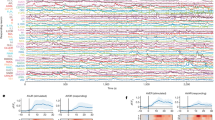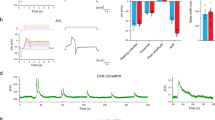Abstract
Small, high-impedance neurons with short processes, similar to those found in the soil nematode Caenorhabditis elegans, are predicted to transmit electrical signals by passive propagation. However, we have found that certain neurons in C. elegans fire regenerative action potentials. These neurons resembled Schmitt triggers, as their potential state appears to be bistable. Transitions between up and down states could be triggered by application of the neurotransmitter glutamate or brief current pulses.
This is a preview of subscription content, access via your institution
Access options
Subscribe to this journal
Receive 12 print issues and online access
$209.00 per year
only $17.42 per issue
Buy this article
- Purchase on Springer Link
- Instant access to full article PDF
Prices may be subject to local taxes which are calculated during checkout



Similar content being viewed by others
References
de Bono, M. & Maricq, A.V. Annu. Rev. Neurosci. 28, 451–501 (2005).
Yu, F.H., Yarov-Yarovoy, V., Gutman, G.A. & Catterall, W.A. Pharmacol. Rev. 57, 387–395 (2005).
Goodman, M.B., Hall, D.H., Avery, L. & Lockery, S.R. Neuron 20, 763–772 (1998).
Davis, R.E. & Stretton, A.O. Parasitology 113 Suppl: S97–S117 (1996).
Raizen, D.M. & Avery, L. Neuron 12, 483–495 (1994).
Shtonda, B. & Avery, L. J. Exp. Biol. 208, 2177–2190 (2005).
Davis, R.E. & Stretton, A.O. J. Neurosci. 9, 415–425 (1989).
Zheng, Y., Brockie, P.J., Mellem, J.E., Madsen, D.M. & Maricq, A.V. Neuron 24, 347–361 (1999).
Brockie, P.J., Madsen, D.M., Zheng, Y., Mellem, J. & Maricq, A.V. J. Neurosci. 21, 1510–1522 (2001).
Francis, M.M. & Maricq, A.V. Methods Mol. Biol. 351, 175–192 (2006).
Frokjaer-Jensen, C. et al. J. Neurobiol. 66, 1125–1139 (2006).
Humphrey, J.A. et al. Curr. Biol. 17, 624–629 (2007).
Zheng, Y., Mellem, J.E., Brockie, P.J., Madsen, D.M. & Maricq, A.V. Nature 427, 451–457 (2004).
Gray, J.M., Hill, J.J. & Bargmann, C.I. Proc. Natl. Acad. Sci. USA 102, 3184–3191 (2005).
Loewenstein, Y. et al. Nat. Neurosci. 8, 202–211 (2005).
Acknowledgements
We thank M. Vetter and members of the Maricq laboratory for comments on the manuscript and the Caenorhabditis Genetic Center, funded by the US National Institutes of Health National Center for Resources, for C. elegans strains. This research was made possible by support from the US National Institutes of Health (grant NS35812).
Author information
Authors and Affiliations
Contributions
J.E.M. carried out the electrophysiological experiments and participated in data analysis. P.J.B. generated strains, participated in data analysis and helped prepare the manuscript. D.M.M. provided molecular biology expertise and A.V.M. supervised the experiments, participated in data analysis and wrote the manuscript.
Corresponding author
Supplementary information
Supplementary Text and Figures
Supplementary Figures 1 and 2 (PDF 148 kb)
Rights and permissions
About this article
Cite this article
Mellem, J., Brockie, P., Madsen, D. et al. Action potentials contribute to neuronal signaling in C. elegans. Nat Neurosci 11, 865–867 (2008). https://doi.org/10.1038/nn.2131
Received:
Accepted:
Published:
Issue Date:
DOI: https://doi.org/10.1038/nn.2131



